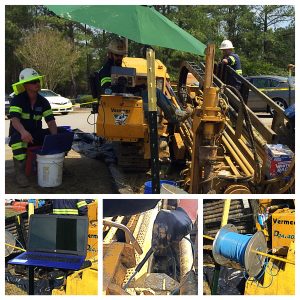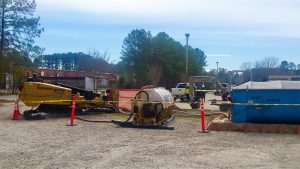Remediation Wells Target Large PCE Plume Under Active Manufacturing Facility
Completing environmental remediation projects at industrial sites can be complicated when operations take place at facilities with limited space to work and restricted access to areas above the wells to be drilled. DTD faced such challenges when a job called for the installation of remediation wells beneath a highly secure aerospace manufacturing facility.
Over a period of six weeks, DTD drilled and installed five horizontal wells beneath the floor of a building as part of an effort to clean up tetrachloroethylene (PCE) left in the soil and groundwater by previous dry cleaning activities in the 1970’s. The wells target contamination in two different zones ranging from 15 to 23 feet below ground surface and are intended for multiple phases of remediation, including groundwater extraction and chemical injections.
Prior groundwater sampling at the site revealed widespread PCE contamination. Vertical remediation wells are being used to treat areas of high concentration around the facility, but the most impacted area of the site is located directly beneath the primary production area of the building. Rather than installing additional vertical wells inside the building, horizontal wells were selected to target the central plume under the building in an effort to minimize interruptions to ongoing manufacturing processes.

Various aspects of drilling using the SST navigation system.
DTD completed one bore using a walkover navigation system but large machinery and offices limited access to the other bore paths. Thick reinforced concrete and CNC machines and electrical equipment within the plant generated considerable interference that further hindered walkover capabilities. As such, DTD selected Digital Control Inc.’s Short Steering Tool (SST) to provide remote locating capabilities while drilling under the building. The SST is a geomagnetic wireline guidance system that is calibrated to the earth’s magnetic field, enabling precision location readings to be taken at the drill bit. At the operator’s console, a continuous visual display provides constant steering data for pitch (depth adjustments), roll, and yaw (bearing or azimuth) during drilling. Using the SST, the facility was able to operate without disturbance as we drilled under the building and installed the remaining wells within the contaminated plume.
All five wells were completed as continuous boreholes. Well materials consisted of 4” diameter, stainless steel screen and casing. The wells ranged in length from 440’ to 590’, each with 190’ to 380’ of screen in direct communication with the contaminant zone.
To operate the SST and drill the wells, DTD mobilized a smaller drill rig ideally suited for wells ranging from 100 to 800 feet in length, capable of accessing landscaped areas with minimal surface damage. The innovative combination of a small rig and a specialty locating system allowed the wells to be installed on a tightly controlled site with a small construction foot print and very limited disturbance to ongoing activities. Wells are currently being set up for recovery of PCE from the groundwater, and will eventually be used to encourage in-place biological degradation of PCE.

Typical set-up of drill rig and support equipment. Wells start in the parking lot and continue under the manufacturing facility.
For further information about this project or our ability to design and install wells under active or otherwise complex sites, please call DTD directly.